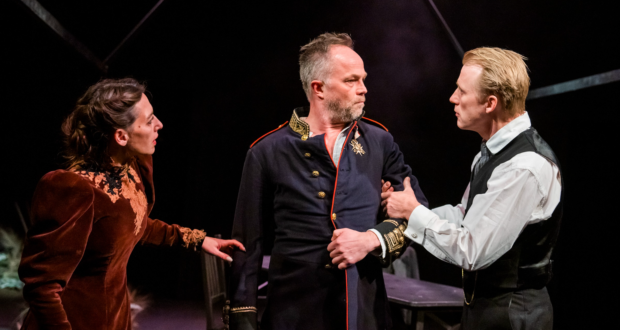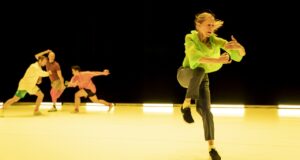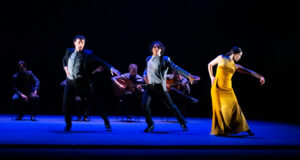A stunning performance of a relationship full of bitterness and despair.Summary
Rating
Excellent
The Coronet has literally raised the Norwegian flag above the theatre in honour of Dance of Death. Transferring in from a sold-out run at The National Theatre of Norway and bringing its original team along, the play is performed in Norwegian with English surtitles.
Edgar (Jon Øigarden) and Alice (Pia Tjelta) have been married for 25 years – and they hate each other. They are alone and bitter as their neighbours have a party without them. Edgar is the commander of the fortress island but seems to have to declare this on a semi-regular basis as if no one would know otherwise. Alice has given up a potentially promising acting career for marriage. They are bitter and trapped: trapped within a circle within a circle, on the island, in the fortress, without money and by marriage. They are estranged from their children, each blaming the other. Yet perhaps they might still love each other. Enough is suggested to indicate at least some degree of love and intimacy, even if perhaps they now thrive on and maybe even live for the conflict.
Kurt (Thorbjørn Harr), an old friend (more to Alice) who comes to visit, is a better man, perhaps even a good man. He might not always have been but he is now and means well. He visits his friends instead of attending the neighbours’ party. The vitriol between the couple which Edgar then shows towards Kurt, mocking him over losing his children in divorce, leaves him unsteady and spiralling downwards.
The stage is strikingly laid out by Even Børsum, using a metal house frame with a dining table and chairs. On one side a chaise longue for Alice, and on the other an armchair and whisky table for Edgar – a corner for each fighter to return to between the constant battles. Plants and rocks combined with a background projection of a raw island vista keep a constant reminder of their isolation.
Director Marit Moum Aune gets everything from her cast: they offer us three intense and captivating performances. Øigarden gives a spirited showing as Edgar toys with Alice and Kurt, and a boorish pomposity. He throws himself into the physicality; an illness affecting Edgar sees him fall or dive across the stage with some gusto. Tjelta plays Alice with a deep strength, giving just as good as she gets from Edgar by luring Kurt to her and then sapping his will. Harr presents Kurt’s descent, from teetotaller to a drunken despairing wreck, unable to cope with Alice and Edgar, with restraint, slowly showing the fall until all that is left is a wreck. The complicated loathing comes across plainly, and it is hard to empathise with anyone as an air of claustrophobia, hatred and despair fills the room.
August Strindberg‘s script, with a translation by Kjell Askildsen, is darkly comedic with sly and pointed lines bringing the occasional bleak laugh. A large contingent of Norwegians in the audience found greater amusement and reacted more than the on-screen surtitles suggested. It seemed that on more than one occasion lines on stage didn’t match up with the screen. Also, having two screens, one on each side, makes it hard to focus on the excellent work of the cast, and I found myself more than once having to choose to look away from the performance to be able to read what was going on. There are times, though, that no understanding of the words is required: the intense performances on stage speak for themselves, as loathing needs no words to be plain to see.
Dance of Death makes for an intense evening but one that is superbly presented by all involved. Let’s hope The Coronet flies the Norwegian flag again in the future!
Written by: August Strindberg
Directed by: Marit Moum Aune
Translated by: Kjell Askildsen
Set and Costume Design by: Even Børsum
Produced by: Nationaltheatret
Dance of Death plays at the Coronet Theatre until 31 March. Further information and bookings can be found here.
 Everything Theatre Reviews, interviews and news for theatre lovers, London and beyond
Everything Theatre Reviews, interviews and news for theatre lovers, London and beyond



